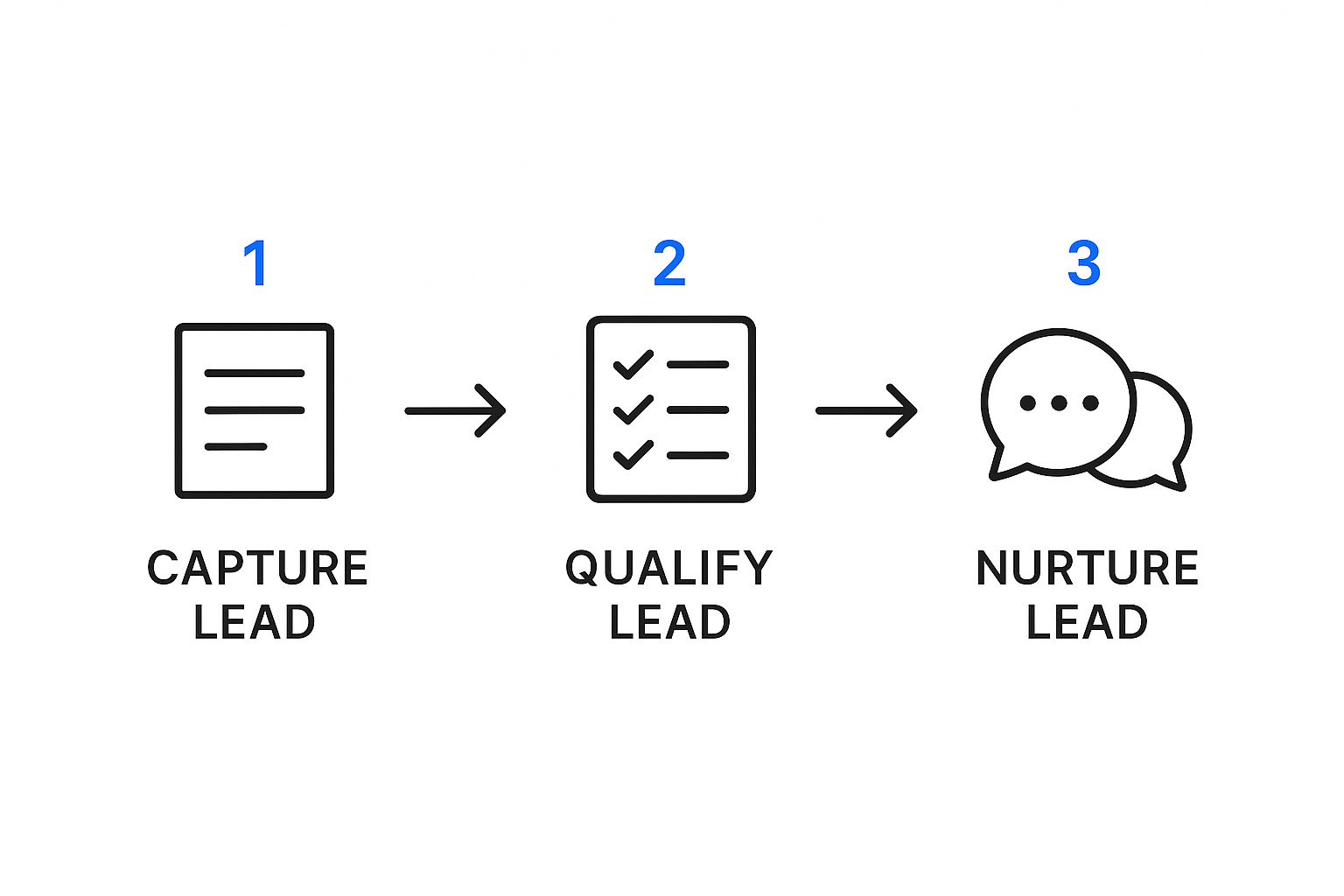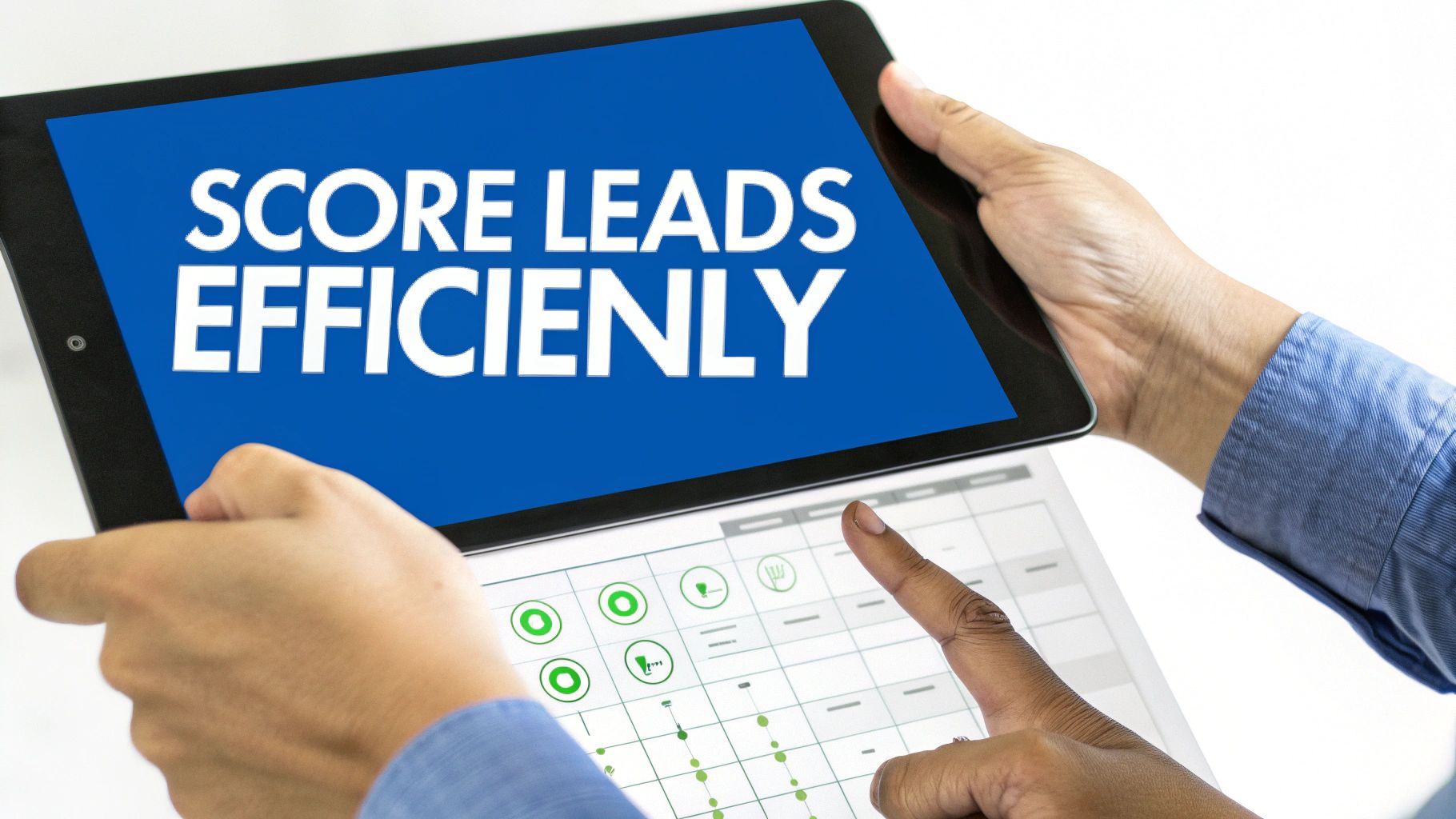Letting a good lead go cold is like setting your marketing budget on fire. It's a painful, preventable waste. That's why having a real system to capture, qualify, and convert potential customers isn't just a "nice-to-have"—it’s how you make sure every dollar you spend on ads actually shows up on the revenue side.
Failing to properly track your sales leads is one of the costliest mistakes you can make. It’s the business equivalent of a leaky bucket; you keep pouring resources in, but potential revenue just slips through the cracks, completely unnoticed. Without a clear system, you're essentially flying blind. You have no real way of knowing which marketing channels are hitting the mark and which are just a drain on your budget.
This goes way beyond just staying organized. It's about making smart decisions that fuel growth. When you can't trace a closed deal back to its source—whether it was a specific Facebook ad, a blog post, or a Google search—you can't intelligently decide where to double down. You're stuck making gut decisions, and that's a terrible strategy for scaling a business.
The financial hit from poor tracking is staggering when you look at the numbers. While lead generation is a top priority for 50% of marketers, the challenges are just as significant. With the average cost per lead sitting at around $198.44, every single prospect that gets lost in the shuffle is a direct, tangible loss.
Worse yet, 44% of sales reps admit they're often too swamped to follow up with leads effectively. This points to a massive disconnect between getting a lead and actually turning it into a customer.
This diagram breaks down the basic journey every lead should follow in a healthy system.

As you can see, it really boils down to three key phases: grabbing their initial interest, figuring out if they're a good fit, and then guiding them toward a sale.
To fix the leaks and build a predictable sales engine, you need a simple framework. I've seen this work for countless businesses, and it always comes back to these three core activities.
To bring this to life, let's walk through a simple, yet powerful, framework for tracking leads from start to finish.
This table maps out the fundamental flow. Each stage builds on the last, creating a seamless handoff from your marketing efforts to your sales team.
Here’s a closer look at what each stage entails:
The goal here isn't just to collect a list of names and emails. It's to build a predictable, repeatable pipeline. A solid lead tracking process transforms raw interest into measurable revenue and gives your team the clarity to focus only on the opportunities that matter.
Getting this right is what connects the dots between your marketing spend and your bottom line. If you're looking to dig even deeper, we have a guide on improving your lead tracking process that offers more detailed steps. This foundation is crucial before we jump into the specific tools and tactics to make it all happen.
Look, your tools should work for you, not pile on more work. When we talk about how to track sales leads, putting together a smart, integrated tech stack is step zero. Forget about those endless lists of software you see everywhere. The real secret is understanding the "why" behind each piece of the puzzle. You want to build a seamless system that hands your team actionable insights, not just another dashboard they have to remember to check.
At the center of this whole setup, you need a single source of truth. For us, and for anyone serious about lead tracking, that means implementing a rock-solid CRM system. This is non-negotiable. It’s the central hub where every bit of lead data—from every single channel—lives, breathes, and gets updated in real time.
Once your CRM is in place as the foundation, you can start layering in the more specialized tools that paint the full picture of the customer journey. The rule is simple: every tool must feed data back into your CRM, enriching each lead's profile with context that your sales team can actually use.
Let’s make this real. Imagine a B2B SaaS company trying to figure out which blog posts are actually driving demo requests. By hooking their web analytics into their CRM, they can see that a single post on "advanced data security" brought in five high-quality leads last month. Boom. That's a direct signal to double down and create more content around that exact topic.
Here’s a quick breakdown of the tool categories that matter most:
Google Analytics is the 800-pound gorilla here; an incredible 78.5% of companies use it for tracking website leads. But its real power isn’t unlocked until you integrate it with your other platforms—your CRM, for sure, but also tools like Google Tag Manager for granular event tracking. When you combine these, you get that complete picture of lead activity, which lets you fine-tune your marketing with absolute precision.
For instance, this screenshot shows a pretty standard Google Analytics dashboard, highlighting where users are coming from.

On its own, this data is useful, sure. But once it's connected to your CRM, you might discover that "Organic Search" doesn't just bring in the most traffic—it also delivers the leads with the highest close rate. Now that's an insight you can take to the bank.
Your goal is a tech stack where data flows automatically between systems. A new lead from a Facebook ad should instantly pop up in your CRM, already tagged with the exact campaign that brought them in. This completely eliminates manual data entry and gives your sales team immediate, valuable context for their first outreach call.
This level of integration is especially critical for B2B businesses, where the sales cycle is longer and more complex. If that's your world, check out our detailed guide on lead generation for B2B SaaS to see exactly how a connected stack fuels explosive growth. When the right tools work together, they transform a mess of abstract data points into a clear, compelling story about every single lead.
Let’s be honest, collecting raw lead data is the easy part. The real work—and where the money is made—is turning that list of names and emails into something your team can actually use. This is where a smart tagging and segmentation strategy comes in. It’s how you transform a flat contact list into a dynamic database that tells a story.
Forget about generic labels like ‘hot’ or ‘cold.’ A modern tagging system should give you a complete picture at a glance.
Imagine a sales rep opens a new lead in their CRM and immediately sees these tags: LinkedIn-Ad-Q3, Pricing-Page-Visit, and Industry-Healthcare. Before they even think about dialing, they know exactly where this person came from, what they’re interested in, and their business context.
That kind of intel is a game-changer. Instead of a generic "Hi, I'm calling from..." opener, the rep can lead with something far more effective: "I saw you came across our LinkedIn campaign and spent some time on our pricing page for healthcare teams. What specific challenges are you trying to solve right now?"
A truly useful tagging system doesn't happen by accident; it needs a solid, structured approach. The goal is for your tags to provide immediate context across several key dimensions, letting you slice and dice your audience for incredibly effective communication. You want a system that answers the most important questions about a lead without anyone having to dig through paragraphs of notes.
Here’s a practical framework I've seen work time and time again for building descriptive tags:
Google-Organic-Blog, Facebook-Ad-eBook, or Webinar-Live-Attendee. This is non-negotiable for figuring out which marketing channels are actually driving value.Demo-Request and Case-Study-Download to Abandoned-Cart-HighValue. These tags are pure gold because they signal intent and tell you who to follow up with first.Company-Size-50-200, Role-Marketing-Manager, or Geo-NorthAmerica are vital for tailoring your message.Think of your tags as building blocks. When you combine them, they create a comprehensive profile that makes hyper-personalized marketing and sales not just possible, but easy. A lead tagged with Google-Organic-Blog, Case-Study-Download, and Company-Size-50-200 is a completely different conversation than one tagged with Facebook-Ad-eBook and Company-Size-1-10.
This approach gives your sales team the clarity they need to prioritize their day and arms your marketing team with the segments they need to run targeted nurturing campaigns that actually convert.
Understanding the lead's source is especially critical. For a deeper look into this, our guide on understanding lead attribution breaks down how to directly connect your marketing efforts to sales outcomes. By implementing a smart tagging system, you’re no longer just collecting data—you’re actively using it to drive revenue.
Alright, let's transform that data from a simple collection into a real money-maker. The truth is, gathering all that rich, detailed lead data is just the starting line. Where the magic really happens is when you start using those insights to actually guide people toward a purchase.
This is the moment your tracking efforts translate directly into revenue. It’s how you turn a spreadsheet of raw data into a predictable sales engine. Frankly, all the tracking data in the world is useless if you don't have a solid plan to act on it.
The key is to build smart, automated follow-up sequences based on the specific breadcrumbs your leads leave behind. This is the difference between carpet-bombing your list with generic emails and sending truly personal messages that actually connect.
Think about it. Imagine two new leads just hit your system.
One downloaded your "Beginner's Guide to XYZ." The other just sat through a deep-dive technical webinar on your most advanced features. Sending them the same follow-up would be a colossal waste of an opportunity. Data-driven nurturing lets you treat them like the unique individuals they are.

Here's how that might look in practice:
This targeted approach ensures every lead gets the right message at the right moment, which massively boosts your chances of making a sale. Your tracking data—those tags you set up for lead source and on-site behavior—becomes the trigger that kicks off these powerful, automated workflows.
This isn't just fluffy marketing theory; it's a direct path to a healthier bottom line. Effective lead nurturing isn't a "nice-to-have"—it's a core growth driver.
The numbers don't lie. 74% of companies say lead nurturing is their top priority. And for good reason. Companies with strong nurturing programs see a 20% jump in sales opportunities. Even better, businesses that get really good at this generate 50% more sales-ready leads at a 33% lower cost. That's a clear, undeniable ROI.
The big takeaway is this: when you nurture leads based on their tracked behavior, you stop hoping for sales and start systematically creating them. You're meeting people exactly where they are, building trust, and showing them you get what they need.
This whole process ensures those leads you worked so hard to get don't just sit there. It moves them purposefully through your funnel and, ultimately, turns your tracking insights into a reliable revenue machine.
By connecting your lead capture to intelligent follow-up, you close the loop and can finally start accurately tracking closed-won revenue from your campaigns.
Collecting lead data is one thing; turning it into a real competitive advantage is where the magic happens. Think of all that data you've meticulously tracked as a roadmap. It shows you exactly where to refine your strategy, slash wasted ad spend, and double down on what’s actually working.
This is the part where you stop guessing and start making informed decisions that directly boost your bottom line. The goal isn't just to stare at pretty charts; it's to spot the trends that scream "action required!"
For instance, what if you discover that leads from organic search have a 30% higher Customer Lifetime Value (CLV)? That's not just a cool stat. It's a powerful signal telling you precisely where to invest more of your marketing budget for sustainable, long-term growth.

This level of insight moves you beyond surface-level metrics. You’re now in the realm of strategic optimization, where every data point informs a smarter business decision.
One of the biggest traps you can fall into with data is getting distracted by vanity metrics. These are the numbers that look great in a report but tell you absolutely nothing about the health of your business. To truly understand performance, you have to separate what feels good from what actually drives growth.
A classic example is a huge spike in social media followers. It looks impressive, but if it doesn't translate into actual leads or sales, it's just noise.
An actionable metric, on the other hand, is something like your Lead-to-Customer Conversion Rate by Channel. This tells you which of your marketing efforts are most effective at turning genuine interest into cold, hard revenue.
The core difference is simple: Vanity metrics make you feel good, while actionable metrics help you make better decisions. Your entire analysis should be focused on the latter.
It’s easy to get lost in the sea of data available today. This table helps cut through the noise so you can focus on the numbers that truly matter for growing your business.
By focusing on the right metrics, you can confidently allocate resources, knowing you're investing in channels and strategies that have a proven impact on your bottom line.
To build a robust analysis process, you need to anchor your efforts around a few critical Key Performance Indicators (KPIs). These are the metrics that give you the clearest, most unfiltered view of your funnel's health and efficiency.
Here are the essentials you should be tracking:
By consistently monitoring these KPIs, you can shift from making reactive adjustments to building a proactive, data-driven strategy. If you want to dive even deeper into connecting these dots, our guide on sales funnel analytics offers a more detailed look at building a data-first pipeline.
Your lead tracking data is a goldmine—these are the tools to start digging.
Of course. Here is the rewritten section, crafted to sound like it was written by an experienced human expert, following all your specified requirements.
As you start piecing together your lead tracking system, you're bound to run into a few head-scratchers. That’s totally normal. Nailing this stuff isn’t about flipping a switch; it’s a process of tweaking, testing, and getting things just right for your business.
Think of this as your go-to FAQ. We’ll break down some of the most common questions and roadblocks I see teams face, with straight-up answers to help you build a process that actually moves the needle.
Honestly, for a small team, the best CRM is the one you’ll actually use every single day. It's so easy to get mesmerized by massive platforms like Salesforce or HubSpot and their endless feature lists, but most of those bells and whistles just create noise when you're starting out.
Look for a tool that’s known for being clean and intuitive. Many of the newer CRMs have fantastic free or low-cost plans built for teams just like yours. I'd recommend prioritizing these core features:
The whole point is to build on a simple foundation that gives you immediate value without overwhelming your team. You can always migrate to a more complex system later when you genuinely need the extra horsepower.
Ah, the classic handoff debate. Getting this wrong is one of the fastest ways to create friction between your marketing and sales teams and let good leads go cold.
The key is to create a crystal-clear, mutually agreed-upon definition of a Sales Qualified Lead (SQL). And I mean mutually agreed upon—this can’t be a decision made in a marketing silo. Sales has to buy in completely.
The handoff isn't about interest; it's about intent. A lead is ready for sales when their actions signal they are actively considering a purchase, not just learning about the topic.
Think of it this way: someone who downloads your "Ultimate Guide to X" ebook is probably a Marketing Qualified Lead (MQL). They're interested, but they're still in research mode.
But when that same person signs up for a product demo, revisits your pricing page three times in a week, and works at a company that fits your ideal customer profile? That’s a five-alarm fire. They’ve crossed the threshold into SQL territory. An automated workflow should ping a sales rep immediately to get in touch.
This data-first approach takes the guesswork out of the equation. It makes sure your sales team isn't wasting time on tire-kickers and can focus their energy on prospects who are actually ready to talk business. Aligning on this is fundamental to making your entire sales lead tracking process work.
Ready to eliminate the guesswork and see exactly which marketing efforts are driving your sales? Cometly provides crystal-clear attribution, unifying your data to show you what's working and where to optimize your ad spend. See how Cometly can transform your marketing ROI today.
Learn how Cometly can help you pinpoint channels driving revenue.
.svg)
Network with the top performance marketers in the industry